Introduction
In a world where physical well-being often takes a backseat to busy schedules and endless responsibilities, the importance of core workouts cannot be overstated. These foundational exercises are not merely about aesthetics; they are essential for building a resilient body capable of navigating daily challenges with strength and stability. By engaging the core muscles, individuals can enhance their athletic performance, reduce injury risks, and improve overall posture—benefits that resonate deeply, especially for those who spend long hours at a desk.
This article delves into the significance of core training, offering a comprehensive guide to designing effective workouts, debunking common myths, and integrating these vital exercises into a holistic fitness regimen. Embracing core workouts is a powerful step toward not just physical fitness, but a healthier, more productive lifestyle.
Understanding the Importance of Core Workouts
Core workouts, including a full body core workout, form the bedrock of a well-rounded fitness regimen, essential for cultivating a strong and resilient body. The foundational muscles, encompassing the abdominals, obliques, and lower back, are pivotal for stability, balance, and overall movement efficiency. Recent studies emphasize that a strong foundation not only enhances athletic performance but also reduces injury risks and encourages proper posture—key factors for individuals who spend extensive hours at a desk.
Notably, a study by Weston et al. (2013) involving 36 participants with an average age of 47 ± 12 years revealed that age significantly influences performance metrics, emphasizing the necessity for accessible essential training for adults. Furthermore, a case study titled 'Comparison of Isolated vs Combined Training of the Center' demonstrated that:
- Isolated training of the center (ICT) had a moderate significant effect on throwing/hitting performance (SMD = 0.52, p = 0.008)
- Combined training of the center (CCT) showed a large significant effect (SMD = 1.67, p = 0.02)
By emphasizing fundamental exercises, individuals can improve their physical well-being, enhancing daily activities and promoting a healthier, more productive lifestyle. As Daniel Jerez-Mayorga notes, 'The right training approach can lead to remarkable improvements in performance and overall well-being.' Therefore, embracing a full body core workout is not just beneficial—it's a vital step towards achieving optimal health and performance.
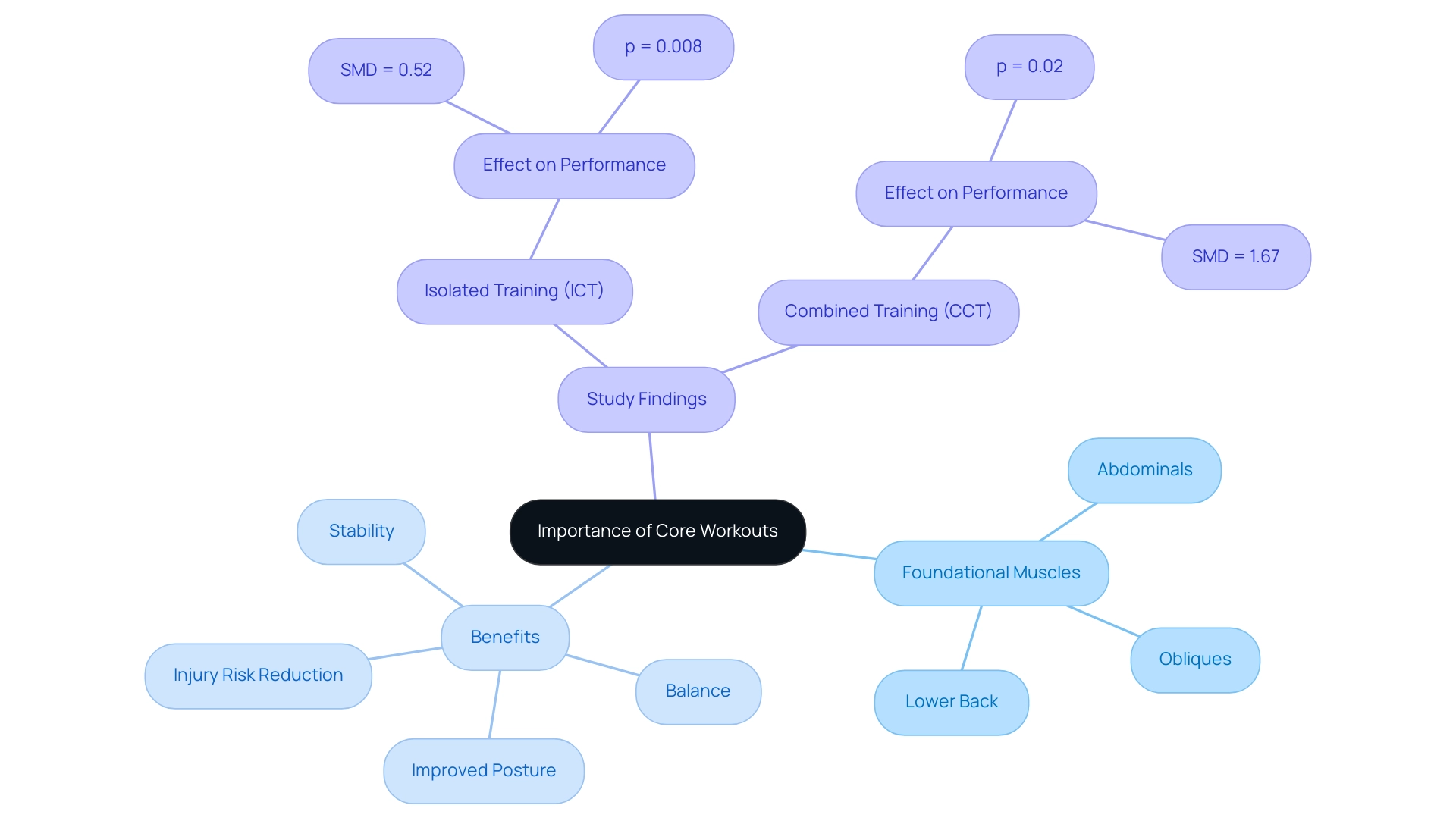
Step-by-Step Guide to Designing Your Full Body Core Workout
-
Assess Your Fitness Level: Begin your journey by evaluating your current fitness level. This crucial step allows you to choose activities that are not only appropriate but also safe. At Foresight Health Coaching, we emphasize professional assessments to ensure your team is set up for success, considering any physical limitations.
-
Set Clear Goals: Establishing clear objectives is essential for motivation and focus. With only 17% of participants reporting exercising two days a week at all time-points, it’s vital to set realistic and achievable goals. Determine what you wish to achieve with your full body core workout—whether it’s boosting strength, enhancing endurance, or improving stability. These goals will guide your exercise selection and overall approach.
-
Choose the Right Duration: Consider the time you can realistically dedicate to your exercise. A full-body exercise routine usually lasts from 20 to 60 minutes. Finding the right duration helps maintain consistency and keeps your team engaged.
-
Select Activities: Tailor your activity selection to meet your goals. Our offerings at Foresight include a full body core workout that encompasses a range of activities involving all areas of the core, incorporating both dynamic and static movements to guarantee a well-rounded fitness routine. This variety keeps the routine interesting and maximizes effectiveness.
-
Plan the Structure: Organize your exercise routine with a thoughtful structure. A proven approach is to perform 2-3 sets of 10-15 repetitions for each activity. This structure helps in sustaining focus and monitoring progress, making exercises feel manageable and rewarding.
Include Warm-up and Cool-down: Never underestimate the power of a good warm-up and cool-down. A proper warm-up readies your muscles for the activity ahead, while a cool-down encourages recovery, significantly boosting the overall effectiveness of your training routine. Remember, these steps are essential for injury prevention and long-term success.
-
Leverage Foresight’s Unique Offerings: By integrating our corporate membership benefits, such as in-person wellness talks and comprehensive nutrition services, you can enhance your team's experience. Additionally, utilizing our health and wellness app provides ongoing support and connectivity among employees, fostering a culture of health and well-being in your workplace.
As emphasized by our founders, integrating these elements into your routine fosters a culture of health and well-being in your workplace. By following these steps, you can effectively create fundamental exercise routines that address the unique needs of your team, supported by Foresight Health Coaching's customized programs.
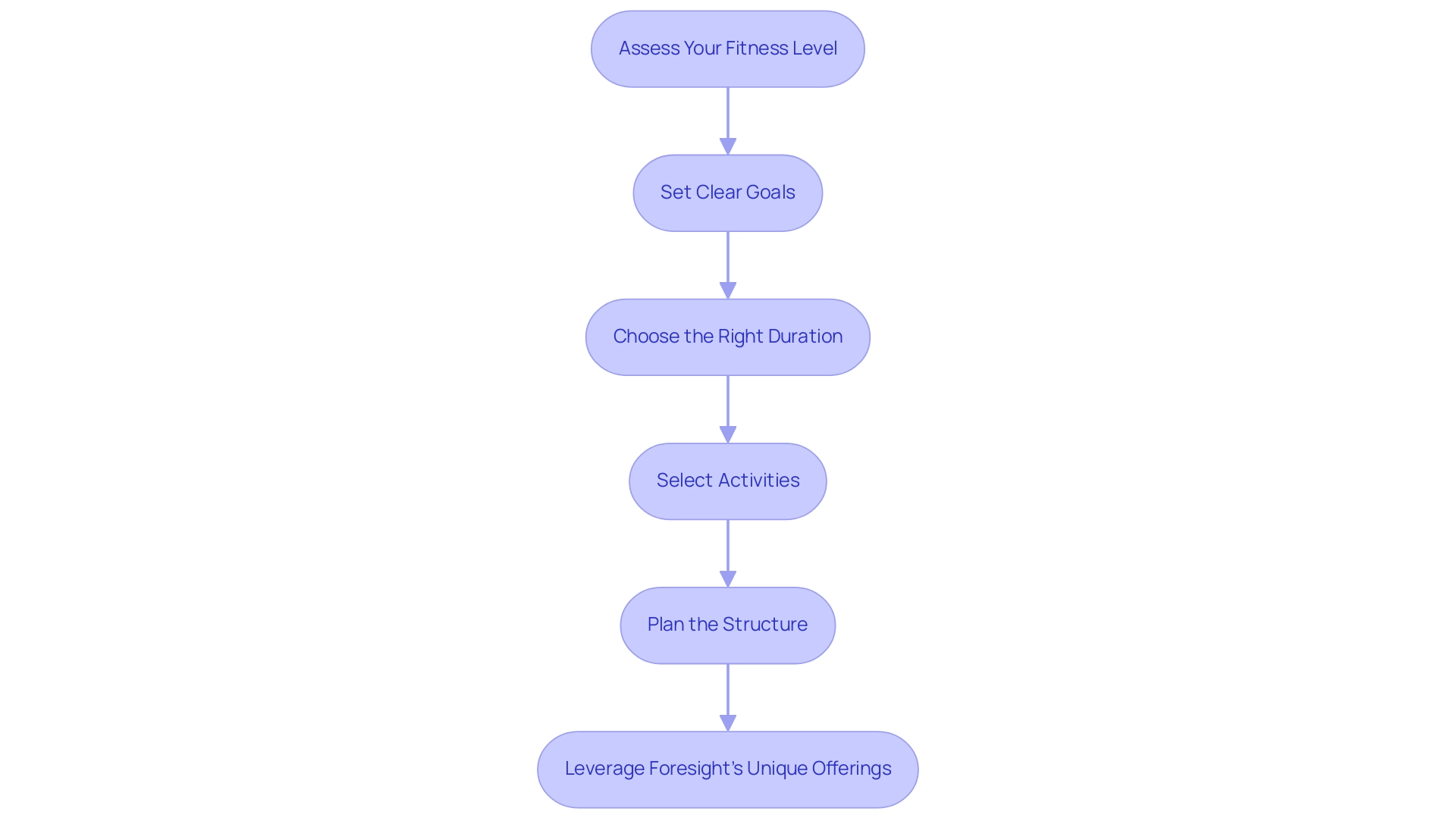
Essential Exercises for a Comprehensive Core Workout
- Plank: This fundamental movement is a powerhouse for engaging various abdominal muscles, including the rectus abdominis (RA), internal obliques (IO), external obliques (EO), and erector spinae (ES). Start by holding the plank position for 30-60 seconds, gradually increasing your duration as your strength improves. Research by McGill & Masrshall (2012) underscores the plank's effectiveness, making it a staple in any full body core workout (PMID: 37867742).
- Russian Twists: Targeting the obliques, this versatile movement can be performed with or without weights. Aim for 2-3 sets of 10-15 twists per side. The advantages of Russian twists go beyond abdominal strength; they improve rotational stability and are renowned for their contribution to functional training. However, it is crucial to recognize that additional investigation is required on transverse abdominis (TA) activation during such activities, as emphasized by José M Muyor, who stated, 'a lack of research concerning TA activation during physical fitness routines was revealed, along with a lack of consistency between the studies when applying methods to measure EMG activity'.
- Bicycle Crunches: Known for their effectiveness in targeting both the upper and lower abdominal muscles, bicycle crunches should be performed in 2-3 sets of 10-15 repetitions. Including this activity in your routine can greatly enhance overall abdominal strength and stamina.
- Dead Bug: This exercise is excellent for building stability, emphasizing slow and controlled movements. Aim for 2-3 sets of 10-12 repetitions. The dead bug not only fortifies the center but also improves coordination and balance, making it ideal for individuals beginning their fitness journey.
- Mountain Climbers: A dynamic movement that elevates your heart rate while engaging the abdominal muscles, mountain climbers should be performed for 30 seconds to 1 minute, with 2-3 sets recommended. This exercise showcases the benefits of a full body core workout by effectively integrating aerobic and central training for maximum impact.
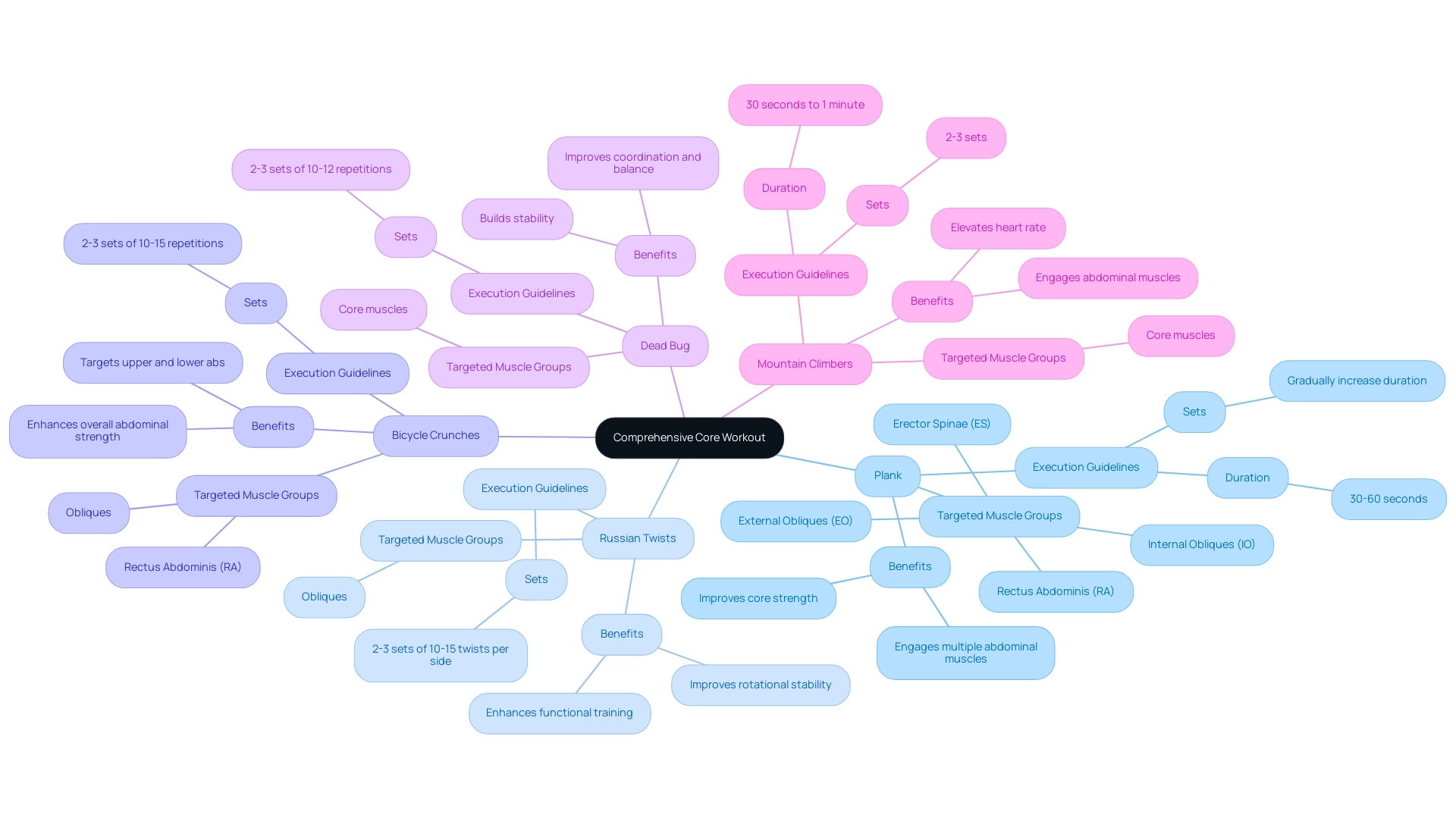
Debunking Myths and Maximizing Core Training Effectiveness
- Myth: Central training is only for abs: Many believe that central training focuses solely on the abdominal muscles, but the truth is that these exercises engage a complex network of approximately 29 muscles, including those in the back and pelvic floor. This holistic approach not only enhances physical appearance but also supports a full body core workout, improving functionality and overall movement in daily life.
- Myth: You need to do hundreds of reps: Another common misconception is that endless repetitions are necessary for effective abdominal training. In reality, prioritizing quality over quantity is essential. Focus on executing movements with proper form and control, as this will yield better results than sheer volume ever could.
- Myth: Training for stability is only for athletes: It’s a misconception that only athletes can benefit from stability workouts. In truth, a strong core is vital for everyone, as it supports essential daily activities, enhances posture, and reduces the risk of injury. This foundational strength is crucial for overall health and well-being, which is why a full body core workout is an important pursuit for individuals at all levels of physical activity.
- Myth: Crunches are the best way to build abs: Some fitness professionals argue that crunches are not the most beneficial way to build your abs because they are not functional movements, and the repetitive forward flexion of the spine could cause unnecessary compression on spinal discs. Instead, a variety of fundamental activities should be incorporated to develop strength effectively.
- Debunking spot reduction: Many individuals think that performing abdominal routines will specifically burn fat in the abdominal area. However, case studies explain that exercising abdominal muscles does not lead to spot reduction; instead, it highlights the need for overall body fat reduction through a calorie deficit. Fat loss necessitates a combination of consistent physical activity and a healthy diet, along with individual factors like genetics and hormones.
- Maximize effectiveness: To truly harness the benefits of fundamental training, incorporate a full body core workout along with a diverse range of exercises into your routine. Focus on upholding correct form and progressively pushing your limits by increasing resistance or extending the duration of your exercises. This approach will not only fortify physical strength but also foster a sense of capability and confidence in your abilities.
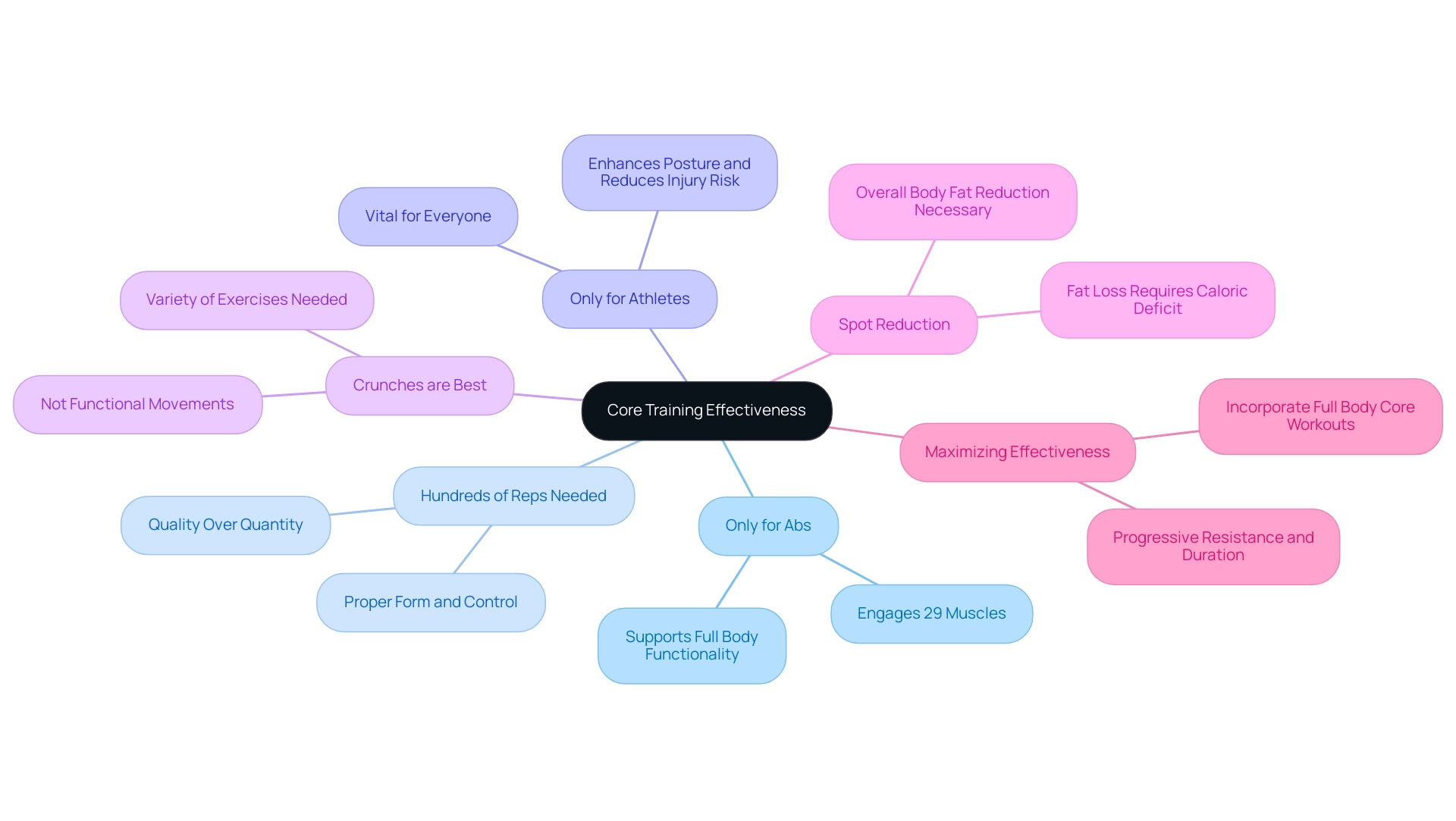
Integrating Core Workouts into Your Overall Fitness Regimen
- Schedule Regular Full Body Core Workouts: To build a strong foundation, include a full body core workout in your fitness plan 2-3 times each week. This frequency aligns with expert recommendations, allowing for optimal muscle activation and recovery. According to McGill & Marshall (2012), this frequency is especially beneficial for male participants aged 25.60 ± 3.40 years, providing a demographic context for these recommendations.
- Merge with Other Fitness Activities: Improve your routine by incorporating essential workouts with cardio, strength training, and flexibility routines. Research by Tarnanen et al. indicates that upper limb activities can effectively engage central muscles, making it advantageous to combine these components for a holistic approach. Additionally, Saeterbakken et al. (2015) assessed the impact of row exercises on muscle activation, further endorsing the case for incorporating various exercises.
- Utilize Short Sessions: When time is limited, choose shorter, high-intensity abdominal exercises that can be finished in merely 15-20 minutes. This strategy not only maximizes efficiency but also ensures that a full body core workout remains accessible, even for those with busy schedules. Our customized corporate wellness programs guarantee that these exercises are designed to accommodate various fitness levels, offering assistance for employees in diverse environments, including those in office settings.
- Listen to Your Body: Stay attuned to your body's feedback after workouts. Modify your routine as needed to avoid burnout and promote recovery, making sure that your primary training stays effective and enjoyable. Our tailored coaching plans provide personalized guidance to assist employees in navigating their wellness journeys effectively.
- Stay Consistent: Consistency is the cornerstone of progress. By incorporating essential workouts as a regular part of your exercise routine, you will develop strength and improve overall performance. Remember, attaining noticeable outcomes, such as six-pack abs, demands commitment to a balanced method that incorporates a full body core workout along with a low body fat percentage and strategic exercise practices. As highlighted in the case study context, achieving six-pack abs necessitates not only abdominal training at least once a week but also a combination of overall fitness strategies. By investing in these tailored corporate wellness programs, you are not only enhancing your team's health but also boosting productivity and cognitive performance across the board. Moreover, our customized app provides easy access to workout plans and progress tracking, further supporting employees in overcoming the unique challenges they face in office environments, such as long hours of sitting and limited time for exercise.
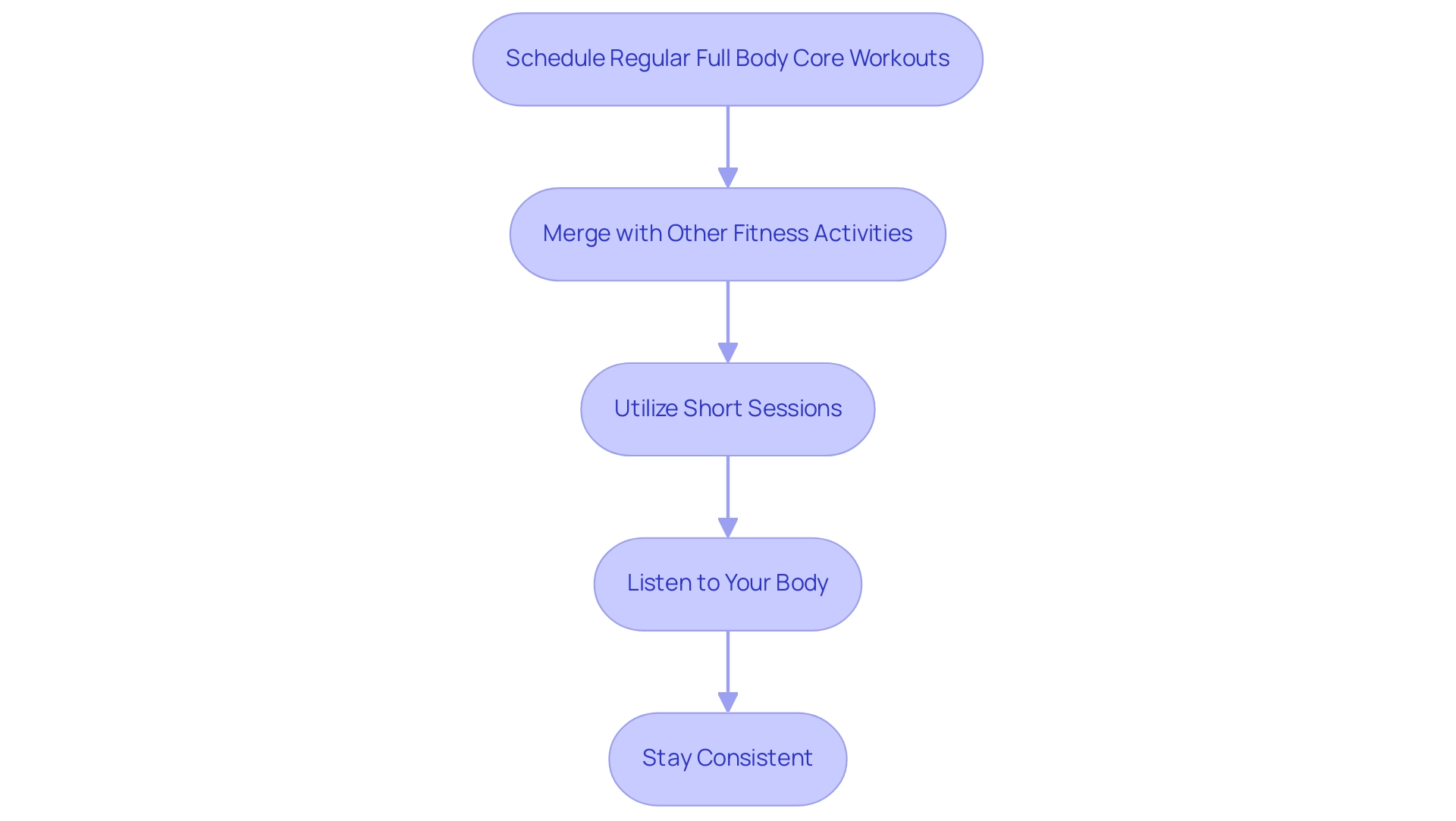
Conclusion
Core workouts are an indispensable component of any fitness regimen, serving as the foundation for a strong and resilient body. By engaging the core muscles, individuals can improve stability, enhance athletic performance, and reduce the risk of injury—benefits that are particularly crucial for those with sedentary lifestyles. Moreover, the process of designing effective core workouts involves:
- Assessing fitness levels
- Setting clear goals
- Incorporating diverse exercises that promote overall wellness
Addressing common myths surrounding core training is essential to maximize its effectiveness. Understanding that core workouts engage a complex network of muscles and that quality trumps quantity can transform the way individuals approach their fitness. Incorporating a variety of exercises not only bolsters strength but also fosters a sense of capability and confidence.
Integrating consistent core workouts into a broader fitness routine can yield significant benefits. By scheduling regular sessions and combining them with other fitness activities, individuals can create a comprehensive approach to health. This commitment to core training not only enhances physical well-being but also contributes to improved productivity and overall quality of life.
Ultimately, embracing core workouts is a proactive step toward achieving optimal health and performance. By prioritizing these vital exercises, individuals can cultivate a stronger body capable of meeting the demands of daily life, paving the way for a healthier, more productive future.
Frequently Asked Questions
Why are core workouts important for fitness?
Core workouts are essential for cultivating a strong and resilient body, as they strengthen foundational muscles like the abdominals, obliques, and lower back. These muscles are crucial for stability, balance, and overall movement efficiency, enhancing athletic performance and reducing injury risks.
What benefits do core workouts provide?
Core workouts improve stability, balance, and movement efficiency, which can enhance athletic performance, reduce injury risks, and promote proper posture, especially for individuals who spend long hours at a desk.
How does age influence core workout performance?
A study by Weston et al. (2013) indicated that age significantly affects performance metrics, highlighting the need for accessible core training for adults.
What findings were observed in the study comparing isolated and combined training of the core?
The study found that isolated training of the center had a moderate significant effect on throwing/hitting performance (SMD = 0.52), while combined training of the center showed a large significant effect (SMD = 1.67).
What is the recommended approach to creating a full body core workout?
A full body core workout should include fundamental exercises tailored to individual goals, with a structure of 2-3 sets of 10-15 repetitions for each activity, ensuring a well-rounded routine.
How long should a full body core workout typically last?
A full body core workout usually lasts between 20 to 60 minutes, depending on the time available and the individual's fitness level.
What role do warm-ups and cool-downs play in core workouts?
Warm-ups prepare the muscles for activity, while cool-downs promote recovery. Both are essential for injury prevention and enhancing the overall effectiveness of the training routine.
How can Foresight Health Coaching support core workout routines?
Foresight Health Coaching offers professional assessments, tailored workout programs, in-person wellness talks, and a health and wellness app to support individuals in creating effective core workout routines and fostering a culture of health in the workplace.




